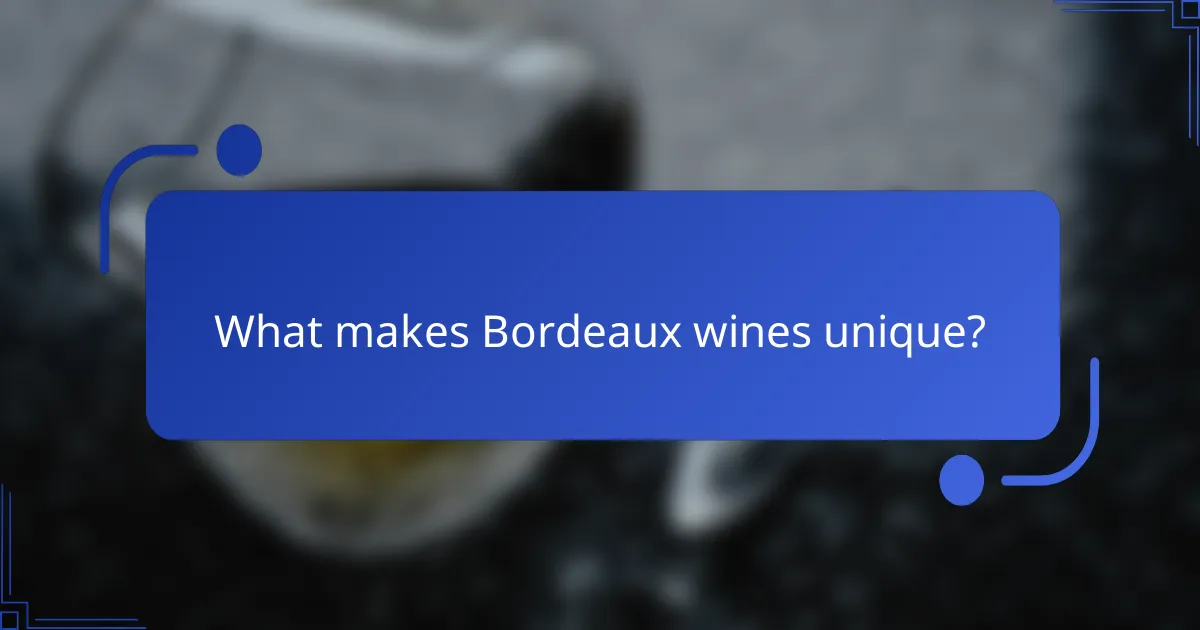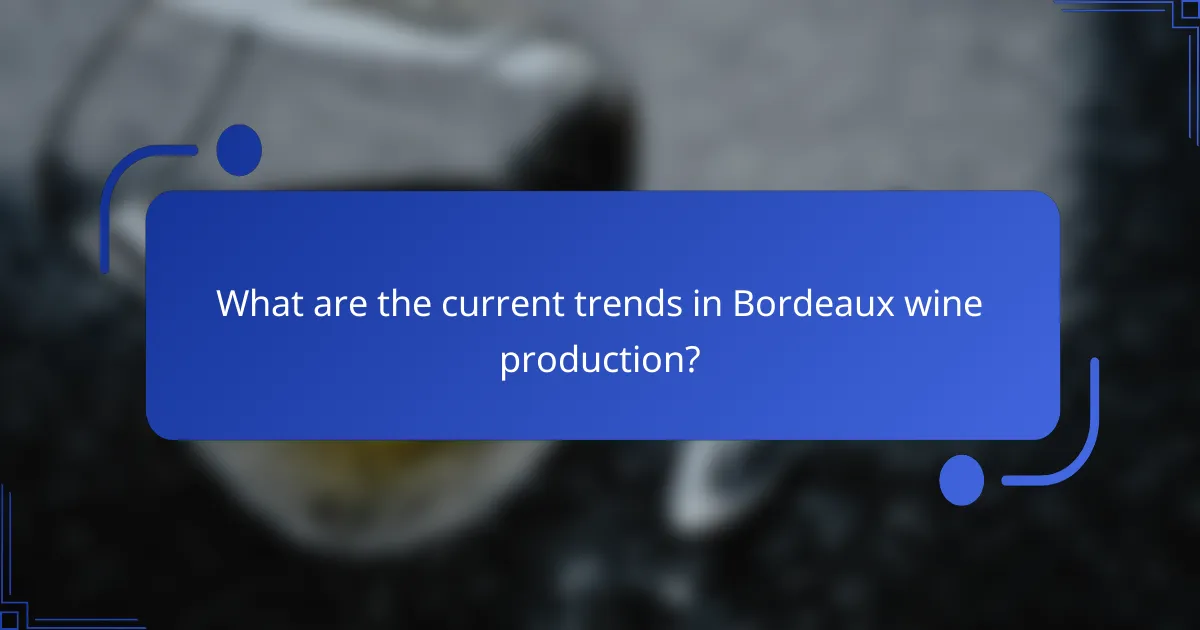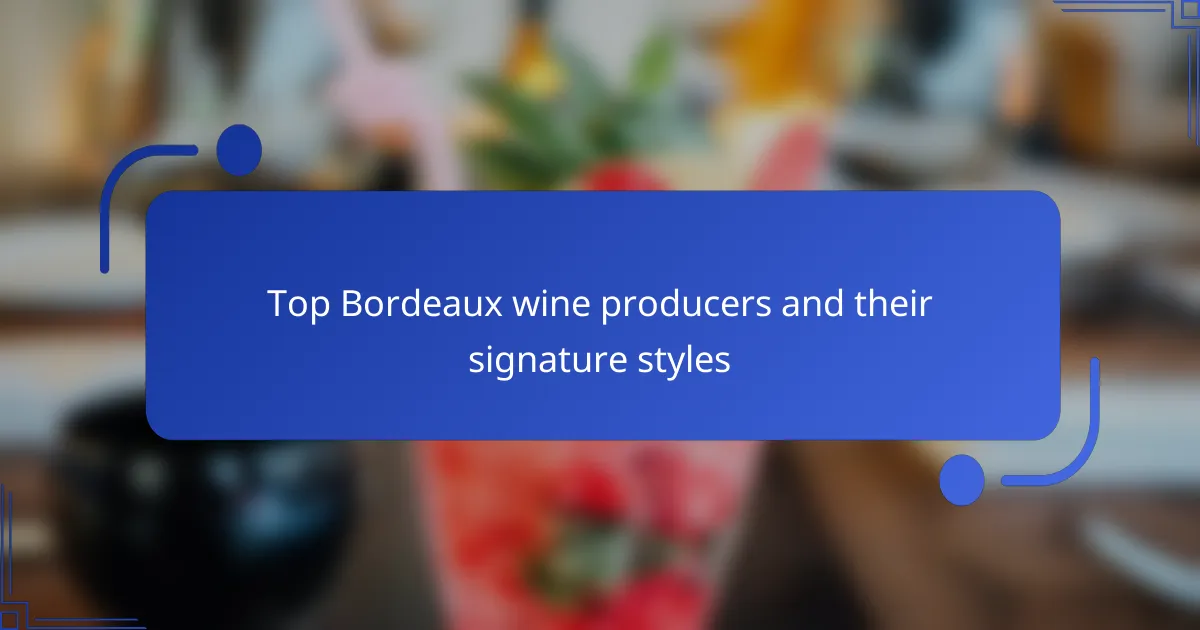
What are the top Bordeaux wine producers?
The top Bordeaux wine producers include Château Margaux, Château Lafite Rothschild, and Château Latour. Château Margaux is known for its elegant and fragrant wines, often featuring Cabernet Sauvignon. Château Lafite Rothschild produces wines with a reputation for finesse and longevity, primarily using Cabernet Sauvignon and Merlot. Château Latour is recognized for its powerful and full-bodied wines, predominantly crafted from Cabernet Sauvignon. Other notable producers are Château Haut-Brion, which is famed for its complex and aromatic blends, and Château Mouton Rothschild, celebrated for its artistic labels and robust wines. These producers consistently rank among the best due to their historical significance, quality, and influence in the wine industry.
How do we define a top Bordeaux wine producer?
A top Bordeaux wine producer is defined by a combination of quality, reputation, and consistency. These producers typically have a long-standing history of excellence in winemaking. They often achieve high ratings from wine critics and publications. Many top producers are classified in the Bordeaux Wine Official Classification of 1855. This classification includes renowned estates like Château Lafite Rothschild and Château Margaux. Additionally, top producers maintain strict vineyard management and winemaking practices. They often use premium grape varieties, such as Cabernet Sauvignon and Merlot. The best Bordeaux wines are characterized by depth, complexity, and aging potential. Thus, a top Bordeaux wine producer is recognized for both their exceptional wines and their influence in the wine industry.
What criteria are used to evaluate Bordeaux wine producers?
Bordeaux wine producers are evaluated based on several criteria. Key factors include the quality of the grapes used. The grape variety and its ripeness significantly impact the wine’s flavor profile. Terroir, which encompasses soil, climate, and geography, is also crucial. The winemaking techniques employed by the producer influence the final product. Aging potential is assessed by experts, as it determines the wine’s longevity and complexity. Additionally, consistency in quality across vintages is an important criterion. Ratings from wine critics and competitions provide an external benchmark for evaluation. Historical reputation and market demand further contribute to the assessment of Bordeaux wine producers.
Which Bordeaux wine producers are historically significant?
Château Margaux, Château Lafite Rothschild, and Château Latour are historically significant Bordeaux wine producers. Château Margaux has roots dating back to the 16th century. It is renowned for its elegant Cabernet Sauvignon blends. Château Lafite Rothschild is one of the oldest classified estates, established in the 13th century. It is famous for producing high-quality wines with great aging potential. Château Latour, established in the 14th century, is known for its powerful and long-lived wines. These producers are part of the Bordeaux Five, a group recognized for their influence on the wine industry. Their contributions have shaped Bordeaux’s reputation globally.
What are the notable regions within Bordeaux?
The notable regions within Bordeaux are Médoc, Saint-Émilion, Pomerol, Graves, and Sauternes. Médoc is known for its prestigious châteaux and Cabernet Sauvignon wines. Saint-Émilion is recognized for its Merlot-dominant blends and historic vineyards. Pomerol features small estates producing highly sought-after wines, primarily from Merlot. Graves is famous for both red and white wines, particularly its gravelly soils. Sauternes is celebrated for its sweet dessert wines made from botrytized grapes. Each region contributes distinct characteristics to Bordeaux’s overall wine profile.
How does the terroir influence wine production in Bordeaux?
Terroir significantly influences wine production in Bordeaux. Terroir encompasses the geography, geology, and climate of a specific region. Bordeaux’s diverse terroirs contribute to the unique characteristics of its wines. The region’s clay, limestone, and gravel soils affect drainage and nutrient availability. These soil types influence grape varieties that thrive in each area. For example, Merlot flourishes in clay-rich soils, while Cabernet Sauvignon prefers gravelly terrains. The region’s maritime climate also impacts grape ripening and acidity levels. This combination of factors results in wines with distinct flavors and aromas. Bordeaux’s terroir is integral to its reputation for producing high-quality wines.
What are the key characteristics of Bordeaux’s wine regions?
Bordeaux’s wine regions are characterized by a diverse climate, distinct terroirs, and a variety of grape varieties. The region experiences a maritime climate, influenced by the Atlantic Ocean. This climate allows for a long growing season, which is beneficial for grape ripening. Bordeaux is divided into several sub-regions, such as Médoc, Saint-Émilion, and Pomerol, each with unique soil types and microclimates. The predominant grape varieties include Cabernet Sauvignon, Merlot, and Cabernet Franc. Bordeaux wines are known for their complexity and aging potential. The region is also recognized for its classification system, which ranks châteaux based on historical quality. Bordeaux produces both red and white wines, with red being the most prevalent.
What are the signature styles of Bordeaux wines?
Bordeaux wines are known for their diverse signature styles, primarily categorized into red, white, and dessert wines. Red Bordeaux wines typically feature a blend of grape varieties, with Cabernet Sauvignon and Merlot being the most prominent. The style is characterized by rich flavors of dark fruits, tannins, and a balanced acidity.
White Bordeaux wines are often blends of Sauvignon Blanc and Sémillon. These wines are known for their crisp acidity and notes of citrus and stone fruits. Some white Bordeaux wines undergo oak aging, adding complexity and depth to their flavors.
Dessert Bordeaux wines, particularly Sauternes, are renowned for their sweetness and rich, honeyed flavors. These wines are made from grapes affected by noble rot, which concentrates their sugars and flavors.
The signature styles of Bordeaux wines reflect the region’s terroir and winemaking traditions. Bordeaux’s unique climate and soil contribute to the distinctive characteristics of its wines.
How do the grape varieties impact the style of Bordeaux wines?
Grape varieties significantly impact the style of Bordeaux wines. Bordeaux wine is primarily made from five grape varieties: Cabernet Sauvignon, Merlot, Cabernet Franc, Petit Verdot, and Malbec. Each variety contributes unique characteristics to the wine’s flavor profile and structure. Cabernet Sauvignon offers bold tannins and dark fruit flavors, making it suitable for aging. Merlot provides softness and fruitiness, creating a rounder mouthfeel. Cabernet Franc adds floral and herbal notes, enhancing complexity. Petit Verdot contributes color and tannin, while Malbec offers richness and depth. The blending of these varieties allows producers to create diverse styles, from full-bodied reds to lighter, more approachable wines. The regional climate and terroir further influence how these grapes express themselves, resulting in a wide range of Bordeaux wine styles.
What are the typical flavor profiles of Bordeaux wines?
Bordeaux wines typically exhibit a range of flavor profiles, influenced by grape varieties and terroir. Common flavors include dark fruits like blackberry and plum. These wines often have herbal notes, such as green bell pepper or mint. Oak aging adds flavors of vanilla and spice. Tannins are generally firm, providing structure. Bordeaux wines can also exhibit earthy characteristics, like leather or tobacco. The blend of Merlot, Cabernet Sauvignon, and Cabernet Franc contributes to these profiles. Each vintage can enhance or alter these flavors, reflecting the growing conditions.

What makes Bordeaux wines unique?
Bordeaux wines are unique due to their diverse grape varieties and distinct terroir. The region primarily uses Merlot, Cabernet Sauvignon, and Cabernet Franc. These grapes contribute to the wines’ complexity and flavor profiles. Bordeaux’s terroir combines clay, limestone, and gravel soils. This variety in soil types enhances the character of the wines. The region also benefits from a temperate maritime climate. This climate allows for balanced ripening of grapes. Bordeaux wines are often aged in oak barrels. This aging process adds depth and richness to their flavors.
Why are Bordeaux wines considered prestigious?
Bordeaux wines are considered prestigious due to their rich history, quality, and unique terroir. The Bordeaux region has been producing wine for centuries, dating back to Roman times. It is home to some of the world’s most renowned vineyards, such as Château Margaux and Château Lafite Rothschild. These estates consistently produce high-quality wines that are sought after globally. Bordeaux wines often feature a blend of grape varieties, primarily Cabernet Sauvignon and Merlot, which contribute to their complexity. The region’s unique climate and soil conditions enhance the grapes’ development, leading to distinctive flavors. Additionally, Bordeaux wines are often aged in oak barrels, adding depth and character. The classification system established in 1855 further solidified the prestige of Bordeaux wines, establishing a hierarchy that remains influential today.
What historical factors contribute to the prestige of Bordeaux wines?
Bordeaux wines are prestigious due to their long-standing history and reputation. The region has been producing wine since Roman times, establishing early trade routes. By the 12th century, Bordeaux’s wines gained popularity in England, enhancing their status. The 1855 Classification ranked Bordeaux wines, solidifying their quality perception. Bordeaux’s unique terroir, including diverse soils and microclimates, contributes to exceptional wine characteristics. The establishment of the Bordeaux Wine Council in 1948 further promoted quality standards. These historical factors collectively elevate the prestige of Bordeaux wines in the global market.
How does the classification system affect Bordeaux wine reputation?
The classification system significantly enhances Bordeaux wine reputation. It establishes a hierarchy that ranks wines based on quality and historical performance. The 1855 Classification is the most recognized, categorizing wines into five growths. This classification influences consumer perception and pricing. Higher-ranked wines often command premium prices and attract collectors. The system also guides buyers in selecting wines with a proven track record. Consequently, wines from classified estates are often viewed as more prestigious. This reputation can lead to increased demand and market value. The classification system, therefore, plays a crucial role in shaping the Bordeaux wine landscape.
How do Bordeaux producers differentiate their styles?
Bordeaux producers differentiate their styles through grape selection, blending techniques, and terroir. Each producer chooses specific grape varieties based on their desired flavor profiles. Common grapes include Merlot, Cabernet Sauvignon, and Cabernet Franc. The blending process allows producers to create unique combinations that enhance complexity. Terroir, which encompasses soil type, climate, and location, significantly influences the wine’s characteristics. For instance, wines from the Left Bank often emphasize Cabernet Sauvignon, while those from the Right Bank focus on Merlot. Additionally, aging methods, such as the use of oak barrels, further contribute to distinct styles. These factors collectively result in a diverse range of Bordeaux wines, each with its own signature.
What are the unique attributes of leading Bordeaux producers?
Leading Bordeaux producers possess unique attributes that distinguish them in the wine industry. These attributes include a strong commitment to terroir, which reflects the specific environmental conditions of their vineyards. Many leading producers utilize traditional winemaking techniques, emphasizing craftsmanship and quality.
They often blend multiple grape varieties, primarily Cabernet Sauvignon, Merlot, and Cabernet Franc, to achieve complexity in flavor. Notably, several producers have a long-standing history and heritage, contributing to their reputation and influence in Bordeaux.
Additionally, leading producers invest in state-of-the-art technology while maintaining traditional practices, ensuring consistency and excellence in their wines. Many are recognized for their exceptional aging potential, with some wines capable of maturing for decades.
Their unique attributes are often highlighted in prestigious wine ratings and awards, showcasing their excellence on a global scale.
How do winemaking techniques vary among Bordeaux producers?
Winemaking techniques among Bordeaux producers vary significantly based on individual philosophies, grape varieties, and terroirs. Some producers emphasize traditional methods, such as hand-harvesting and natural fermentation. Others adopt modern techniques, including temperature-controlled fermentation and the use of cultured yeasts.
The choice of oak barrels also differs; some producers prefer new French oak for aging, while others utilize older barrels to minimize oak influence. Irrigation practices can vary too; some producers rely on natural rainfall, while others implement irrigation to manage vine health.
Additionally, blending practices differ among producers. Some focus on specific varietals, while others create blends that reflect the region’s diversity. The timing of harvest can also vary, with some producers harvesting earlier for higher acidity and others waiting for full ripeness.
These variations contribute to the unique profiles of Bordeaux wines, showcasing the individuality of each producer.

What are the current trends in Bordeaux wine production?
Current trends in Bordeaux wine production include a focus on sustainability and organic practices. Many producers are adopting biodynamic farming methods. This shift aims to enhance vineyard health and wine quality. Additionally, there is an increase in the use of technology for precision viticulture. Drones and sensors are being utilized to monitor vine health and optimize yields.
Another trend is the rise in popularity of lighter, fresher red wines. These wines appeal to changing consumer preferences. Moreover, Bordeaux producers are exploring new grape varieties to adapt to climate change. This experimentation may lead to unique blends and styles.
Finally, there is a growing emphasis on wine tourism. Bordeaux is becoming a destination for wine enthusiasts. This trend enhances the region’s visibility and promotes its diverse offerings.
How is sustainability impacting Bordeaux wine production?
Sustainability is significantly impacting Bordeaux wine production by promoting environmentally friendly practices. Many Bordeaux producers are adopting organic and biodynamic farming methods. These methods reduce chemical usage and enhance soil health. Bordeaux vineyards are also implementing water conservation techniques. This helps to address climate change challenges. Additionally, sustainable practices improve wine quality and marketability. For instance, the Bordeaux Wine Council reports a rise in organic vineyard certifications. This trend reflects consumer demand for sustainable products. Overall, sustainability is reshaping Bordeaux’s wine industry for the better.
What practices are Bordeaux producers adopting for sustainability?
Bordeaux producers are adopting various sustainable practices to enhance environmental responsibility. Many vineyards are implementing organic and biodynamic farming methods. These practices reduce chemical usage and improve soil health. Additionally, producers are focusing on water conservation techniques. This includes rainwater harvesting and efficient irrigation systems. Many are also investing in renewable energy sources, such as solar panels. This shift helps reduce carbon footprints. Furthermore, Bordeaux producers are engaging in reforestation efforts. These initiatives support biodiversity and combat climate change. Collectively, these practices reflect a commitment to sustainability in the Bordeaux wine industry.
How do consumers respond to sustainable Bordeaux wines?
Consumers generally respond positively to sustainable Bordeaux wines. They appreciate the environmental benefits associated with sustainable practices. Many consumers are willing to pay a premium for wines that are produced sustainably. A survey by the International Organisation of Vine and Wine found that 70% of consumers consider sustainability when purchasing wine. Additionally, younger consumers show a stronger preference for sustainable options compared to older demographics. Sustainable Bordeaux wines often receive higher ratings and better reviews, indicating consumer approval. This trend reflects a growing awareness of environmental issues within the wine industry.
What innovations are being introduced by Bordeaux producers?
Bordeaux producers are introducing innovations focused on sustainability and technology. Many are adopting organic and biodynamic farming practices. This shift aims to enhance soil health and biodiversity. Producers are also utilizing precision viticulture techniques. These techniques involve data analysis for optimal vineyard management. Additionally, some wineries are incorporating new fermentation technologies. These technologies improve wine quality and consistency. Furthermore, Bordeaux producers are experimenting with alternative aging vessels. These include concrete eggs and amphorae, which influence flavor profiles. Overall, these innovations reflect a commitment to quality and environmental stewardship.
How is technology changing the winemaking process in Bordeaux?
Technology is significantly transforming the winemaking process in Bordeaux. Advanced precision viticulture tools are now utilized to monitor vineyard conditions. Drones and satellite imagery provide real-time data on soil health and grape ripeness. This data enables winemakers to make informed decisions on irrigation and harvesting. Additionally, automated systems streamline fermentation processes. Temperature control technologies enhance wine quality and consistency. Furthermore, artificial intelligence is being employed for predictive analytics in blending and aging processes. These innovations lead to improved efficiency and higher quality wines in Bordeaux.
What are the emerging styles of Bordeaux wines in the market?
Emerging styles of Bordeaux wines include natural wines, low-intervention wines, and rosé blends. Natural wines focus on organic and biodynamic farming practices. They often exhibit unique flavors due to minimal intervention in the winemaking process. Low-intervention wines emphasize the use of native yeast and reduced sulfites. This style appeals to consumers seeking authenticity and terroir expression. Additionally, rosé blends from Bordeaux are gaining popularity. They offer a refreshing alternative and showcase the region’s versatility. These emerging styles reflect changing consumer preferences and a shift towards sustainability in winemaking.
What tips should consumers consider when selecting Bordeaux wines?
When selecting Bordeaux wines, consumers should consider the wine’s classification. Bordeaux wines are classified into several categories, including Grand Cru, Premier Grand Cru, and more. Each classification indicates the quality and reputation of the wine.
Next, consumers should evaluate the vintage. Bordeaux wines can vary significantly from year to year based on weather conditions. Researching the specific vintage can provide insights into the wine’s potential quality.
Additionally, consumers should examine the grape varieties used. Bordeaux blends typically consist of Merlot, Cabernet Sauvignon, and Cabernet Franc. Understanding the blend can help consumers anticipate the wine’s flavor profile.
Lastly, consumers should seek recommendations from trusted sources. Wine critics and sommeliers often provide valuable insights into the best Bordeaux wines available. Their expertise can guide consumers toward high-quality selections.
The main entity of the article is top Bordeaux wine producers, which include renowned estates such as Château Margaux, Château Lafite Rothschild, and Château Latour. The article provides an overview of these producers, highlighting their unique attributes, historical significance, and the criteria used to evaluate their wines. It also discusses the influence of terroir, grape varieties, and winemaking techniques on the signature styles of Bordeaux wines. Additionally, the article examines current trends in sustainability and innovation within the Bordeaux wine industry, offering insights for consumers on selecting quality Bordeaux wines.
